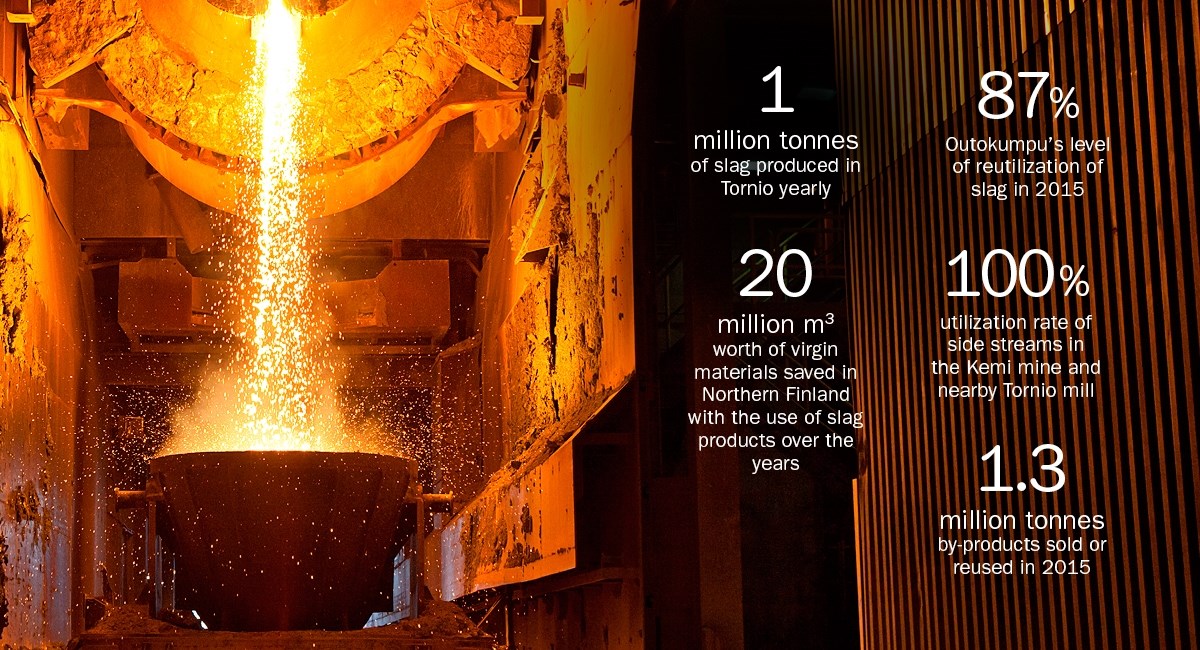Circular economy is a hot global topic. Companies are looking for solutions to create closed loops of material flows – the most successful ones are even able to turn sustainability cases into business cases. Outokumpu walks the talk, and its work is also recognized in global forums.
The goal of circular economy is to put an end to waste. Instead of products and materials having a finite life and ending up at landfill, they could be circled endlessly, and reused as building blocks of other products. In other words, the circular model encourages businesses to operate like living organisms; designing processes to imitate nature’s infinite cycle. This can mean both salvaging valuable materials from processes as well as turning process waste into profit, by reutilizing side streams.
Outokumpu sites in Kemi and Tornio are frontrunners in the circular economy approach, redesigning process waste into usable materials and products.
The infinite cycle of stainless
In the 2015 Paris Climate Talks, the Kemi-Tornio area of Northern Finland was presented as a prime example of an industrial region implementing the circular economy approach. As one of the major players of the region, Outokumpu has been working systematically towards a zero-waste-to-landfill production system ever since the 1990s.
“The main stream of circular economy for Outokumpu is of course the infinite cycle of stainless steel: our steel is 100% recyclable and we have the highest proportion of recycled content in the industry,” states Juha Ylimaunu, Outokumpu’s Vice President, Sustainability and Environment. “In addition, we have put great effort into commercializing the by-products of our plants. For instance, the side streams from ferrochrome production have been utilized since the Tornio plant first started operating in 1968.
Outokumpu’s ferrochrome furnace has a unique clean-tech design, which produces both ferrochrome and a commercially viable slag product.” With around one million tonnes of slag produced in Tornio yearly, reusing the slag has significant environmental and cost-benefits. ”Over the years, the use of our slag products has saved over 20 million cubic meters worth of virgin materials in natural gravel in Northern Finland,” Ylimaunu explains.

Roads, fireplaces and foundations from slag
Outokumpu’s slag-based products have several standardized commercial uses, such as neutralisation in industrial processes and making refractory bricks for fireplaces. Most typically, however, they are used in road and building construction. “In fact, slag products have superior technical features for road bases. They are more durable and allow higher material efficiency,” Ylimaunu explains and stresses that this high level of optimization is a result of years of dedicated development work and improved plant processes. “We study all material streams from production in order to find means of fully reusing or selling them as products on the market. Last year, the Group sold or reused 1.3 million tonnes of by-products and the level of reutilization of slag was 87 percent,” Ylimaunu says. Outokumpu is the only stainless steel producer with its own ferrochrome plant. That enables the company to utilize atypical material flows compared to competitors. The Kemi mine and nearby Tornio mill are able to use a full 100% of side streams which are either sold to private companies and households or reutilized in Outokumpu’s own processes and construction projects.
Saving money and the planet
In the 2000s, the focus has been on developing commercial products out of steel slag. “For over a decade, we’ve made major investments into redesigning the steel slag handling process, so that side streams can be utilized as products,” explains Timo Parviainen, Materials Manager at Outokumpu’s Tornio mill. All in all, Outokumpu sees the circular economy approach as a strategic opportunity, bringing in long-term cost-benefits while mitigating the company’s environmental impacts. “Using recycled stainless and selling our own side streams as slag products is a cost-efficient model that also saves the earth’s resources,” Ylimaunu sums up.
Closing the loop and giving materials new life is a highly effective way to reduce the environmental impact of steel production. Read more about Outokumpu’s sustainability efforts and the Stainless Stainless sustainability concept.
